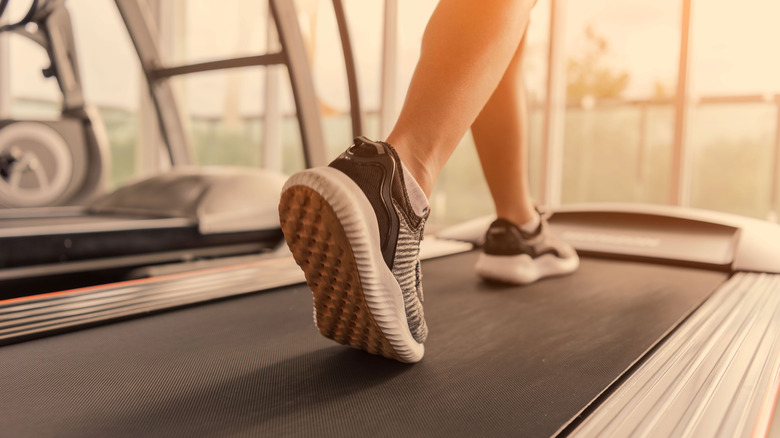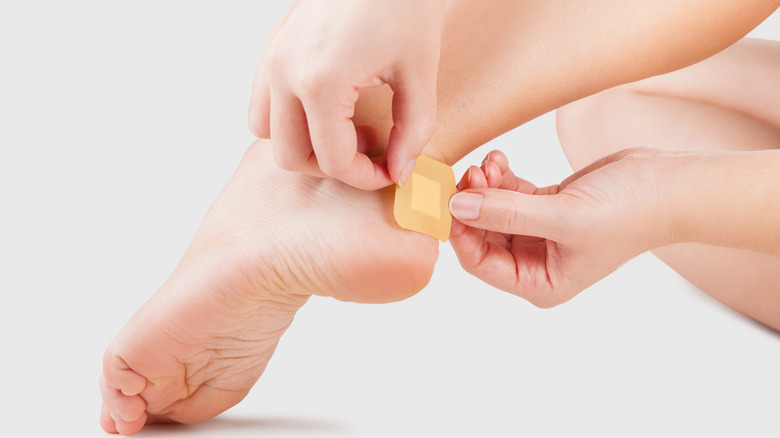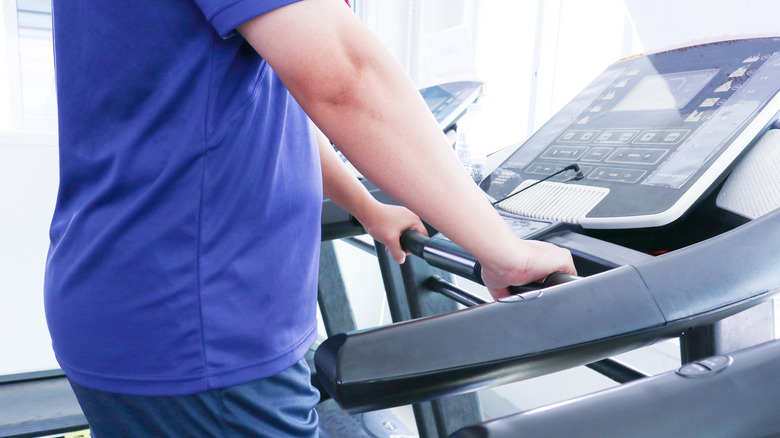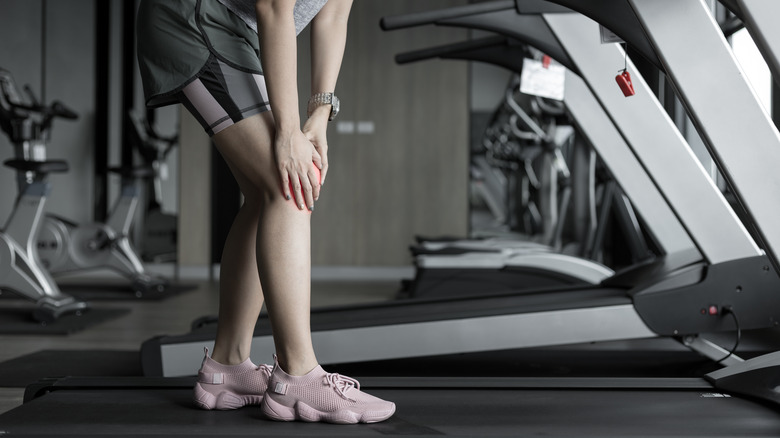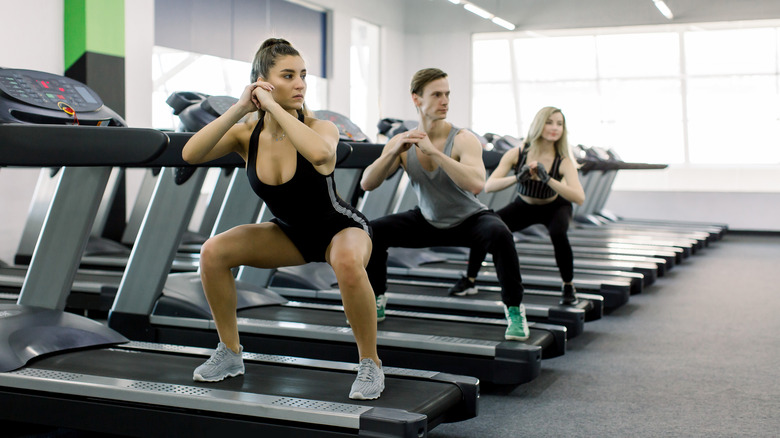What Happens To Your Body When You Use The Treadmill Every Day
Few exercise machines have changed the game as much as the treadmill has. The humble running machine, on which millions of joggers around the world have racked up miles, has never been more popular. According to Statista, treadmill sales in the U.S. have been steadily climbing since 2007, with approximately $1.5 billion spent on the machines in 2020, a testament to their endless appeal.
And we get why people love them. A treadmill is an easy way to get a run under your belt without having to set foot outside. While the debate over running outside versus running on a treadmill rages on (with running outside potentially bearing benefits for stability, and running on a treadmill helping with speed, according to Verywell Fit), there's no denying that for a lot of people a treadmill is a far better option. But what happens to your body if you're using this machine every day? Here at Health Digest, we wanted to find out. On your marks, get set, go!
You'll improve your heart health
It's little surprise that the running you do on a treadmill gets your blood pumping, and all of that activity can provide a serious boost to heart health if done every day. According to Kerry J. Stewart, exercise physiologist for John Hopkins Medicine, aerobic exercise like running has huge benefits for your cardiovascular health. Aerobic exercise activities help to boost your circulation, which helps to manage your heart rate and reduce blood pressure, thereby keeping your risk of heart disease lower. With the recommended level of activity for aerobic exercise clocking in at half an hour for five days a week, hopping on the treadmill daily could be a good way to achieve this goal.
And, if you're looking to maximize your workout on a treadmill to boost your heart health specifically, the Cleveland Clinic has some tips on how to do so. Erik Van Iterson, cardiac rehabilitation director at the clinic, recommends setting a goal during your workout not to achieve a specific distance or speed, but to spend increasing time in your target heart rate training zone, which you can track using a pulse or heart rate monitor. Van Iterson also suggests mixing up your exercise to alternate between higher and lower intensities — this will give your heart a real workout.
Using a treadmill every day will help your bones get stronger
The ceaseless pounding of your feet on a treadmill doesn't just do wonders for your running game — it'll also give a serious boost to bone health. By using a treadmill every day, you could find that your bones get stronger through the exercise by helping them to reshape with more strength, according to a study published in the Journal of Exercise Rehabilitation. The study looked at the impact of running for long-distance runners, specifically on their bone properties. It was found that among the runners, there was an increased marker of bone formation, potentially meaning that bones were able to build back stronger.
Naturally, however, it should be pointed out that the runners being examined in the study were running long distances at a club level, clocking in lots of miles in one go. However, if you're in the mood for extending your treadmill runs to increasing lengths, you could find that your bones get stronger as you do so.
You might not be getting as efficient of a workout as running outside
There's a lot to be said for running on a treadmill: not having to face the wind and rain, or dodge traffic and other pedestrians on city streets — and perhaps most appealingly, not being forced to leave your home to get a workout in. Using treadmills every day might not be as effective as running outside, but what really matters is the efficacy of the workout you're getting. According to Rondel King, an exercise physiologist, certified strength and conditioning specialist, and founder of King Performance, using a treadmill can often mean your body is doing less than if you were running outside (via Runner's World). King states that, when you go for a jog outside, your muscles are activating more "because your feet have to grab the ground to propel you. A treadmill does some of that work for you by feeding the belt to you."
Program Director John Porcari, University of Wisconsin Clinical Exercise Physiology, told Cosmopolitan, "You probably burn about 3 to 7 percent more calories running outside than on a treadmill." While this may not be a huge problem for you if you're not exercising with a specific fitness goal in mind, it is useful information to remember.
You'll increase your likelihood of blisters
It might sound obvious, but running takes its toll on your feet. And when you're hitting the treadmill every day, you're increasing that toll and might be making your potential for blisters more likely. When you run, your feet rub against your socks and shoes, and this friction creates a separation between the top layer of skin and the skin below, according to Verywell Fit. When this separation happens, fluid floods the gap that's left between them, creating painful, annoying blisters.
It's important to point out that running on a treadmill specifically won't increase your likelihood of blisters any more than running outside — but running every day, particularly in less-than-ideal exercise gear, might. Wearing shoes that are too tight, as Verywell Fit points out, can increase the chance of developing blisters, as well as shoes that are too loose. Sports medicine physician David M. Smith, The University of Kansas Health System's, said, "One-hundred percent cotton socks are not the best, as they absorb sweat and stay moist, thus increasing swelling and friction" (via SELF). For that reason, Smith explained, "A material that wicks sweat from the skin through the sock is best."
You might be making your workout easier on yourself without realizing
Have you ever psyched yourself up for the workout of your life, only to find that once you're done, you're left feeling a little underwhelmed? This could be happening to you if you're using a treadmill every day, thanks to the potential for treadmill workouts to be made inadvertently easier. For example, Kansas City-based exercise physiologist Greg Justice, author of "Mind Your Own Fitness," explained that you shouldn't hold on to the treadmill's bars if you want to feel the burn. In an article for Women's Health Magazine, Justice said, "While it's okay to hold the handles for a little bit of time if there's a safety issue with balance, holding them for too long means that your full weight isn't supported — and, thus, you're not burning as many calories."
Holding on to the bars while you work out can also compromise form, leading to a less effective workout, said John Higgins, Memorial Hermann-Texas Medical Center's director of exercise physiology, to Prevention. This is particularly the case when you're using the incline function on a treadmill, which can lead you to stabilize yourself on the bars, reducing the effort you have to put in. Instead, Higgins said, "You should be nearly vertical with a slight lean (five degrees), not way forward so you're grabbing onto the front of the treadmill."
You could be reducing your risk of chronic disease
Treadmill workouts are a great way to stay healthy, and the good news is if you're using a treadmill every day this is more likely to be the case in the long term. Daily exercise on a treadmill (and daily physical activity in general) can reduce the risk of developing many chronic diseases throughout your life, as the CDC stated. Among the long-term diseases that daily exercise can help to reduce the risk of are mental health conditions like depression and anxiety, heart disease, various types of cancer, type 2 diabetes, and dementia — as well as generally improving your quality of life and function.
It's wise to remember that if you're going from a much lower level of daily activity to exercising every day on a treadmill, it may be harder than you think. As the CDC noted, start your exercise regime gently, gradually building up intensity or time. If you already have a chronic health condition, it's also important to consult with your doctor before starting any new exercise routine, so you can assess together how this new level of activity might impact your health as it already stands.
You could increase your risk of injury
Reducing the likelihood of injury when you exercise is essential to ensure your workouts stay effective and safe long-term. You probably don't want to hear that by exercising on a treadmill every day, you might be increasing your risk of injury — but this is largely through the development of bad habits that chip away at your form and progress, noted Prevention. Some of these habits can be as simple as where you cast your gaze — by looking at your feet when you walk, for example, you can disrupt your balance, place stress on the back of your neck, and misalign your spine, which puts stress on parts of your upper and lower body, according to Auburn University's professor of exercise science Michele Olson.
Your footfall on a treadmill can also cause issues. If you tend to land flat-footed when you run, you can end up "leaning backward as the belt goes forward, which strains back muscles from the force generated through your hips and back," as well as affect your balance, added Higgins. Instead, try to keep your posture vertical when you run, and try to land your foot in the middle or on the ball of the foot.
Using a treadmill for just half an hour a day could be super-efficient for weight loss
If you're starting to work out on a treadmill every day, you're likely to see some serious improvements in fitness — and the good news is you don't have to work out for that long to start benefiting. Exercising for less time on a treadmill could be even more beneficial than working out for longer, according to a study published in the American Journal of Physiology.
The study, discussed by Everyday Health, compared the results of two groups following two different exercise regimes, with one group exercising for an hour a day, and the other exercising for 30 minutes daily. While you might assume the group that worked out more saw greater results, the group that worked out for 30 minutes daily actually ended up losing more weight overall (although both groups lost the same amount of fat). The researcher who conducted the study reasoned that, when you work out for less time, you put more effort in, and have more time to recover between sessions. You also don't assume that you have more calories to spare and counteract your exercise by eating more.
Your muscles might be weaker than if you run outside
Whether you're running on a treadmill or running outside, doing it daily may likely lead to a host of health benefits. But where running outside has the edge on running on a treadmill daily is in the improvements you'll see to your leg-muscle strength. Although running in either format will lead to general leg-strength improvements when exercising at adequate intensity, Rondel King said, "If you're only running inside, certain muscles could become weak and de-conditioned, which sets you up for injury when you do get back to running outside" (per Runner's World).
The reason for this is largely a practical one. When you're running outside, there are far more variables to consider, such as things to dodge and rising ground, leading to far greater activation of different muscles in your legs. Never fear, though: If running on a treadmill is your only option, it could be useful to incorporate leg-strengthening exercises into your workout routine to make sure your lower half stays strong and functional. Exercises like squats, lunges, and heel raises — as well as targeted variations of these — can all help runners strengthen their legs, according to Active.
You could be at risk of overtraining
Exercising every day, in any form, can quickly push your body to its limits. And when this happens — and you don't take the rest that your body needs — you could quickly enter overtraining territory. Symptoms of overtraining are, importantly, different from the regular post-exercise feeling, advised Marci A. Goolsby, MD, medical director of the Women's Sports Medicine Center at the Hospital for Special Surgery (or HSS). "It's natural and expected to feel fatigued after challenging training sessions," Goolsby said. "But feeling like you aren't recovering between sessions or experiencing overall fatigue and difficulty pushing yourself during workouts can be indicators of overtraining" (per the HSS).
Symptoms of overtraining can also manifest in other ways, with signs including persistent or extreme muscle soreness, a harder time relaxing, increased irritability, confusion or depression, and insomnia. If you notice any symptoms of overtraining, or generally feel like you're overdoing it when working out, it's important to stop before you make things worse. Take some time to reassess your workout routine. "If the symptoms become more severe and prolonged, the recovery takes much longer," warned Goolsby.
You'll be strengthening your legs — particularly if you're not just running on one
It's easy to assume that working out on a treadmill will benefit your cardiovascular system and heart and blood-vessel strength (per the UTSouthwestern Medical Center) as opposed to your other muscles. But your legs will get an excellent daily workout too when you're running on a treadmill, as Exercise stated. Running activates our muscles through regular explosive contraction, as well as continually activating to maintain balance — with your hamstrings, calves, and quads all playing an enormous part, and this activity naturally builds their strength.
However, as Exercise also pointed out, to continue building strength, you have to place your muscles under more and more stress — doing the same workout every day likely will cause your leg muscles' growth to plateau. But the good news is, that treadmill you've got can be used for way more than just running to build leg strength. Strength exercises like side shuffles, walking lunges, and crab walks can all be performed on a treadmill, adding an extra challenge to your leg muscles, according to Women's Health Magazine.
You'll feel a lot more positive
One of the greatest joys of exercising on a treadmill every day is not just the improvement it gives your fitness, but also the improvement it gives your mood. Working out daily, particularly by doing aerobic exercise like running, can provide incredible benefits to mental health, as research published in Frontiers in Human Neuroscience stated. As the research indicates, aerobic exercise can help to improve brain function by combatting brain dysfunction associated with various mental health conditions.
This is partly why, as research discussed by the National Institute for Health Research suggested, aerobic exercise could be a useful treatment for depression. And, as well as providing long-term benefits to mental health, running can provide short-term boosts to mood, in the form of the adage "runner's high," which gives a sense of happiness and well-being immediately following a solid workout through the release of endocannabinoids into your bloodstream (per Healthline). These endocannabinoids can help to effectively reduce anxiety and increase calm.
You could be boosting your immune system
As well as the myriad other benefits that a daily workout provides, running on a treadmill every day could help to reinforce your immunity. The link between physical exercise and the strength of the immune system has been shown in research published in the Journal of Sport and Health Science and discussed via Health. The research looked primarily at the effects of "acute exercise" on the immune system (for example, a vigorous run on a treadmill), finding that a burst of exercise improves the circulation of immune cells throughout your body, helping it more effectively fight against infection.
Importantly, this is a short-term effect, and one-off exercise won't improve your immunity significantly. However, if you work out consistently — jogging on a treadmill daily, let's say — you continue to top up this impact on your immune system, creating better long-term immunity, according to a study by David Nieman, Appalachian State University's department of biology professor. "If you go out for 45 minutes of exercise the next day, this all happens again," Nieman said. "It all adds up as time goes on."
You could be doing your joints a favor
There's a popular belief that running is an unfriendly exercise for your joints. But for lovers of the jogging life, we've got some good news for you: If you're running on a treadmill, exercising on it at a certain intensity could be way less impactful on your joints than running outside. This is all thanks to how treadmills are designed, according to Rondel King (via Runner's World). The machine, King explained, is made "to absorb ground reaction forces, so it will ideally save your joints from the impact associated with running."
For those concerned about their joints, or who have existing joint conditions like osteoarthritis, treadmill exercise could be far preferable to outside jogging. Having said that, as Healthline pointed out, running at higher intensity, even on a treadmill, can produce a greater impact on your knees and joints, which may be troublesome for certain people. If you're trying to reduce joint impact when running, the best thing to do is keep your pace slow and steady, and pay close attention to form — this will help ensure you're not placing your body under inadvertent stress.



